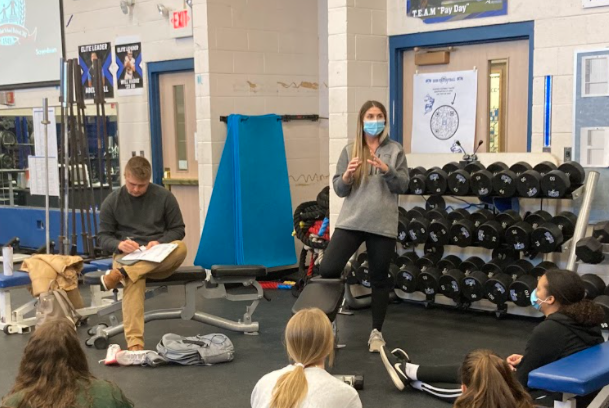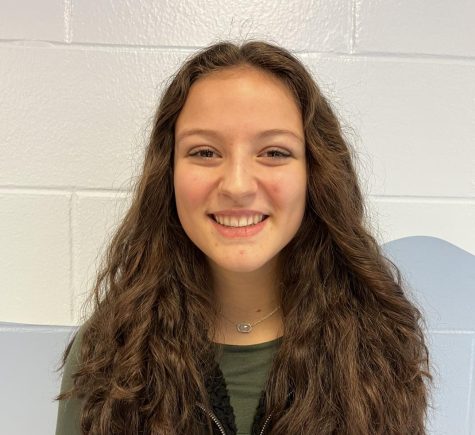How do North Coaches Balance Teaching and Coaching
Mogni and Ivlow talking with the girls track team during practice
March 4, 2022
Not only do students juggle school and extracurricular sports, but several St. Charles North teachers work to find a balance between family, teaching and coaching.
If it weren’t for teachers who give up their own time, North students wouldn’t be able to participate in North’s 33-plus sports teams. Some of these teachers even coach multiple sports, sacrificing even more time during the week to help coach.
Lindsey Hawkins is the head coach of girls varsity volleyball and teaches English. With practices every day after school, coaching takes up a lot of time.
“I would say it’s probably like 20-25 hours a week,” said Hawkins.
Common sense would be to focus on one thing at a time, separating family, teaching and coaching, but it’s not always that easy. With various emails to respond to, phone calls to make and planning to be done, a lot of times Hawkins ends up doing all of her jobs at the same time, causing her to split her focus between the three.
This makes finding a balance extra challenging. However, everybody has their own personal strategies that allow them to navigate their busy lives. Hawkins tries to compartmentalize both of her jobs and her family time, focusing on volleyball when she’s coaching volleyball, focusing on teaching when she’s teaching and focusing on family when she’s at home.
Being an English teacher, Hawkins expresses that her teaching job is pretty extreme due to all of the assignments and grading involved.
“We are constantly grading outside of actually teaching. For as many students as I have, if we’re writing a paper then it probably takes me 20 minutes at least to grade each paper. So my goal is usually to grade five a day so that way I’m keeping up with it, not stressing myself out or overworking, but also not falling behind too. Especially since there’s a lot of other stuff that I need to be doing. But being an English teacher and being a head coach is super hard,” Hawkins explained.
Shari Hayes, another teacher who juggles teaching and coaching, teaches Drivers Ed and P.E. and coaches girls cross country.
“Practices are always between two to three hours; it just depends on what we’re doing. There’s not a day we don’t have practice. And then on Saturday we usually leave at seven in the morning [for a meet], get back about two in the afternoon, sometimes earlier, sometimes later. So it’s a big chunk, but that just covers physical practice. I’m always making workout plans and for cross country, I coach every level, so every single person and every single group I am planning for,” said Hayes.
With all of the planning that Hayes does outside of teaching and coaching, she often sacrifices her sleep to ensure that every kid gets a well thought out and accurate plan.
“I just think you have to be organized. I think if you plan and you organize, it makes it a lot less stressful,” stated Hayes.
Teaching and coaching can be different in many ways, but also very similar, which makes choosing one over the other very difficult, but not impossible.
“I would teach. I know that’s probably not what most people say, but I really enjoy teaching and when I coach, I treat it like teaching. I plan a lot for coaching and I work really hard at trying to tweak things, and I do that when I teach too,” Hayes replied.

Kate Mogni, the head coach of girls track, also teaches health.
With lots of planning and practice being up to two hours, five days a week, it’s “probably 25 hours a week,” said Mogni.
Often, Mogni feels as though waking up, going to work, teaching, coaching, and going to sleep is a never-ending cycle. To try to balance her busy schedule, the days that she doesn’t coach or teach she tries to do nothing related to it in order to step away and take time to relax, unless she absolutely has to.
“Sometimes you just have to kind of draw that line or boundary for yourself,” said Mogni.
Participating in track all through high school, Mogni fell in love with the sport. She continues to coach because she wants the girls to make the friendships and connections like ones she was able to make.
“The athletes. That’s why I do it. I do it for them and to see the joy that it brings them and the excitement that it brings them when they’re succeeding and getting a new PR,” explained Mogni.
Some coaches even go as far as to coach year-round with three different sports due to the athletics seasons.
Kevin Harrington is a Math teacher and additionally coaches three sports: cross country, track and freshman boys basketball.
Each of the sports have different practice times during their respective seasons, but “I would say coaching is probably a good two, two-and-a-half hours a day on a regular day, plus a few hours on the weekend, and once you start meets and games and all that, it pretty easily adds another 20 plus-or-minus hours a week,” said Harrington.
Having older kids at home makes coaching at school a lot easier, eliminating the need to run the kids around, or take care of them constantly.
“For the time that I’m double coaching, if I had little kids or if the circumstances were different, I probably wouldn’t do this,” explained Harrington.
But, it’s still hard for Harrington to fit time in on the weekends with the rest of his family. Harrington explains that you get to coach, you don’t have to. To find a balance between coaching, family and teaching, he looks at it like coaching and teaching are privileges and it is something that he enjoys doing.
“But as soon as you start thinking of coaching as a job, then you don’t have balance because you’re working all the time,” expressed Harrington.
While Harrington coaches three different sports that usually take place during different seasons, sometimes the seasons do overlap. For example, his basketball season overlapped with his track season by about five weeks, which means tons of practice and even less time outside of school.
“I would do a basketball practice here until four thirty, then I got a couple hours off, and then seven to nine for track over at East. So you know if I get here at 5 a.m. and I’m over there until nine, I’ll have a good 12 to 14-hour day,” recalled Harrington.
Michael Ivlow is another teacher who juggles coaching three sports. He teaches Science and Special Education along with Civics and Econ. He also coaches girls track, wrestling and football.
“So overall, about 20 hours a week and 25 hours a week in the fall. When it comes to the winter, I would say about 10 hours, and then if we have tournaments on the weekend, that’s like three or four. In spring, we usually have about five or six hours, so the spring is a lot more doable.”
Striking a balance isn’t always second nature, as some may presume. Finding that balance and making time for everything is how to navigate between the two things. Oftentimes, the best thing to do is to create a foolproof schedule that contains every necessity, and stick to it.
Students and teachers run into the same problem of prioritizing school and extracurriculars. Sometimes, both can be equally as important, so it’s hard to tell in the moment what should come first.
“Your family should always come first, then your job and then extracurricular activities, so a student’s work comes first then athletics comes second,” said Ivlow.
But, it all comes down to if the kids are having fun and if they are getting the most out of their practices. It takes a large amount of motivation to coach so many sports and teach different subjects, but it really takes a large amount of passion.
“Giving them the experience, letting kids reach their maximum potential, and seeing them capture their dreams is my motivator. It’s all about the kids. I’ve found that if the kids are enjoying it and they have a smile on their face, that’s all that matters to me in my opinion,” explained Ivlow.



